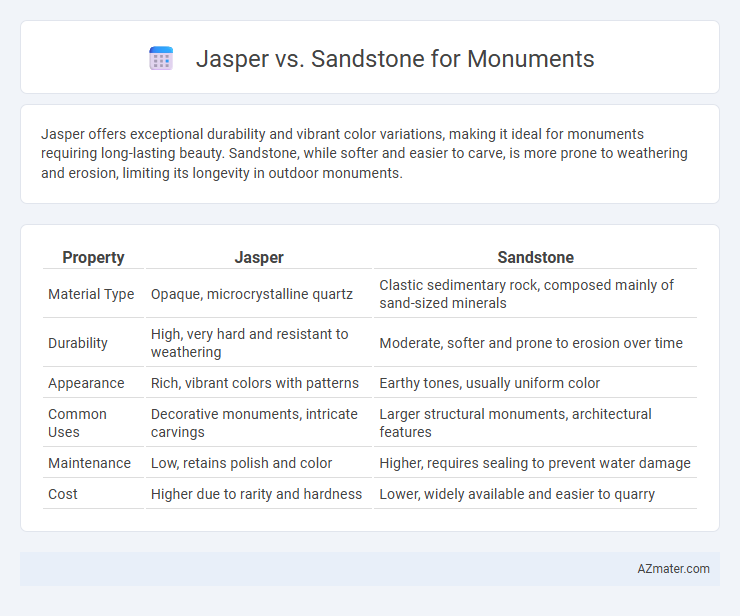Jasper offers exceptional durability and vibrant color variations, making it ideal for monuments requiring long-lasting beauty. Sandstone, while softer and easier to carve, is more prone to weathering and erosion, limiting its longevity in outdoor monuments.
Table of Comparison
| Property | Jasper | Sandstone |
|---|---|---|
| Material Type | Opaque, microcrystalline quartz | Clastic sedimentary rock, composed mainly of sand-sized minerals |
| Durability | High, very hard and resistant to weathering | Moderate, softer and prone to erosion over time |
| Appearance | Rich, vibrant colors with patterns | Earthy tones, usually uniform color |
| Common Uses | Decorative monuments, intricate carvings | Larger structural monuments, architectural features |
| Maintenance | Low, retains polish and color | Higher, requires sealing to prevent water damage |
| Cost | Higher due to rarity and hardness | Lower, widely available and easier to quarry |
Overview of Jasper and Sandstone
Jasper is a dense, opaque variety of chalcedony known for its rich, vibrant colors and patterns, making it highly valued in monument crafting for its aesthetic appeal and durability. Sandstone, composed primarily of sand-sized mineral particles or rock fragments, offers a natural, textured appearance and is favored for its ease of carving and weather resistance. Both materials provide unique qualities for monuments, with jasper excelling in polish and color vibrancy, while sandstone is prized for its rugged texture and structural versatility.
Geological Formation and Composition
Jasper, a microcrystalline variety of quartz, forms through sedimentary processes involving silica-rich fluids crystallizing in volcanic ash or fine sediment, resulting in a dense, hard stone with vibrant iron oxide coloration. Sandstone originates from compacted and cemented sand-sized mineral particles, primarily quartz and feldspar, deposited in sedimentary environments like rivers and deserts, characterized by porosity and varying grain cohesion. The distinct mineral compositions and formation environments of jasper and sandstone influence their durability and suitability for monuments, with jasper offering higher hardness and intricate patterns, while sandstone provides ease of carving and a range of textures.
Physical Properties Comparison
Jasper exhibits a hardness of 6.5 to 7 on the Mohs scale, making it highly resistant to scratches and suitable for detailed engraving in monuments, while sandstone typically rates around 6 to 7 but tends to be more porous and less durable over time. Jasper's fine-grained, dense structure provides excellent weather resistance and color retention, whereas sandstone's sedimentary composition can lead to erosion and surface wear under harsh environmental conditions. The higher compression strength of jasper, often exceeding 200 MPa, contrasts with sandstone's lower strength range of 30 to 170 MPa, emphasizing jasper's superior longevity for monumental applications.
Aesthetic Appeal and Color Variations
Jasper offers a rich, deep range of colors including reds, browns, and yellows with intricate patterns that create striking, unique monuments. Sandstone features softer, earthy tones such as beige, tan, and light brown, providing a warm and natural aesthetic. The choice between Jasper and Sandstone depends on the desired visual impact, with Jasper delivering vivid, bold appearances and Sandstone offering subtle, classic beauty.
Durability and Weather Resistance
Jasper exhibits exceptional durability and weather resistance, making it ideal for outdoor monuments exposed to harsh environmental conditions. Sandstone, while popular for its natural beauty and ease of carving, tends to be more porous and susceptible to erosion over time, especially in wet or freeze-thaw climates. Choosing jasper ensures a longer-lasting monument with minimal weather-related degradation compared to sandstone.
Ease of Carving and Working
Jasper, a dense and fine-grained stone, offers moderate ease of carving for monuments but requires specialized tools due to its hardness, typically around 6.5 to 7 on the Mohs scale. Sandstone, softer with a Mohs hardness of about 6 or less, is significantly easier to carve and shape, making it a preferred choice for intricate designs and detailed work. The workability of sandstone allows artisans to execute complex patterns more efficiently, whereas jasper's durability favors simpler, bold designs.
Maintenance and Longevity
Jasper offers high durability and requires minimal maintenance due to its dense, non-porous structure, making it resistant to weathering and staining, ideal for long-lasting monuments. Sandstone, while aesthetically appealing with its natural texture, demands regular sealing and cleaning to prevent erosion and damage from moisture, impacting its longevity. Choosing jasper ensures a monument with superior preservation and lower upkeep over time compared to sandstone.
Cost and Availability
Jasper is generally more expensive than sandstone due to its rarity and unique color patterns, making it a premium choice for monuments. Sandstone offers a more cost-effective alternative with widespread availability and ease of quarrying, especially in regions like the United States, India, and Australia. While sandstone is favored for large-scale projects due to its abundance, jasper's limited supply and durability contribute to higher prices and selective use in monument construction.
Notable Monuments Made from Jasper and Sandstone
Notable monuments made from jasper showcase its vibrant colors and durability, such as the Egyptian artifacts in the Tomb of Tutankhamun, where jasper was used for intricate jewelry and decorative items. Sandstone monuments, like the Red Fort in India and Petra in Jordan, highlight the stone's workability and strength, enabling large-scale architectural feats with detailed carvings. Both materials have played significant roles in cultural heritage, with jasper preferred for ornamental purposes and sandstone widely used in monumental construction.
Choosing the Right Stone for Your Monument
Jasper offers vibrant colors and intricate patterns that enhance the aesthetic appeal of monuments, while sandstone provides durability and a more natural, earthy texture ideal for outdoor settings. Selecting the right stone depends on factors such as weather resistance, longevity, and the desired visual impact of the monument. Evaluating environmental conditions and maintenance needs ensures the chosen material maintains its integrity and appearance over time.

Infographic: Jasper vs Sandstone for Monument
 azmater.com
azmater.com